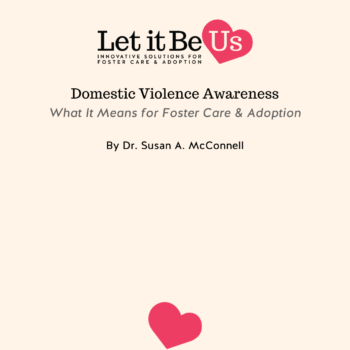How will the loss of SNAP and WIC benefits Impact Children and Teens in Foster Care? Research Driven Information from Let It Be Us
- Latest News
- November 2, 2025

How will the loss of SNAP and WIC benefits Impact Children and Teens in Foster Care?
Research Driven Information from Let It Be Us
By Dr. Susan A. McConnell
At Let It Be Us, we have been actively exploring an urgent question with our child-welfare partners: How will the loss of SNAP and WIC benefits impact children and teens in foster care?
Our mission is rooted in permanency, ensuring that every child in Illinois foster care has the opportunity to grow up in a safe, stable, and loving family. Because our recruitment, matching, and placement programs are education-driven, research-driven, and data-driven, we believe it is essential to understand and share how shifts in public benefits may affect the children and families we serve.
As an agency that prioritizes education and evidence-based practice, we are providing this analysis to help inform statewide conversations and support proactive planning. The research below examines current and proposed SNAP and WIC policy changes and the potential consequences for foster care, permanency outcomes, and family stability. This work is guided by one core truth: food-security supports are proven, upstream prevention tools that reduce foster-care entry, help families remain safely together and support youth aging out of foster care.
Below are the key findings from our research:
For children and teens in foster care (and those at risk of foster care involvement), the loss or reduction of safety-net nutrition supports such as the Supplemental Nutrition Assistance Program (SNAP) and the Special Supplemental Nutrition Program for Women, Infants, and Children (WIC) would have significant and complicated, multi-layered consequences. According to Chapin Hall, access to food assistance programs increases child safety. SNAP and WIC are proven child-safety supports. Cutting or disrupting them increases food insecurity, caregiver stress, and the risk factors that drive DCFS involvement, foster-care entries, and poorer health/education outcomes, especially for teens and youth aging out. chapinhall.org+1
What the Research Tells Us
The following are referenced findings that address how food assistance programs with SNAP and WIC function as stabilizers in child welfare.
- Families who participate in SNAP and/or WIC have lower risk of child protective services (CPS) investigations, entries into foster care, and substantiated maltreatment, especially neglect. For example, one policy brief found that states with more generous SNAP eligibility witnessed large reductions in Child Protection Services (CPS) reports and foster‐care caseloads. AACF+3chapinhall.org+3PMC+3
- Food insecurity is strongly linked to material hardship (lack of food, utilities, housing instability) which is itself a strong predictor of child welfare involvement. familypolicynyc.org+2chapinhall.org+2
- Cuts to SNAP or reductions in benefit levels are associated with worse health outcomes for participating children and their caregivers, e.g., odds of child fair/poor health are higher when families lose benefits. https://www.healthaffairs.org/doi/10.1377/hlthaff.2018.05265
- The policy brief from Chapin Hall (April 2025) states explicitly that food assistance supports are “critical to safeguarding child well-being by reducing economic hardship and assisting families struggling with food insecurity.” chapinhall.org
- Recent advocacy analysis warns that proposed or enacted cuts to SNAP/WIC would increase food insecurity, hunger, poverty among children, with ripple-effects on child welfare involvement. AACF+2Food Research & Action Center+2
In short: SNAP and WIC don’t just feed children, they serve as preventive supports that buttress family stability, reduce stressors that often precede removal, and improve outcomes for children.
The loss or reduction of SNAP or WIC would likely specifically impact child welfare in the following ways:
- If a caregiver loses SNAP or WIC, the immediate material hardship increases (less food, harder to purchase healthy meals, competing demands between food & housing/utility bills). That hardship can increase caregiver stress, the risk of neglect findings, CPS involvement, and potential entry into foster care. (Because the research shows poverty + material hardship → higher child welfare risk).
- With respect to foster home recruitment, the need may rise as more children may enter the system as family supports shrink. There is already a strong demand for placements, and this impact would increase the current demand as well as add complexity, as children come into care with more severe stressors.
- Nutritional deficits (less access to healthy food) can affect cognitive development, school performance and behavior, thus increasing challenges for foster parents and caseworkers. This potential failing nutrition may compound trauma, mental-health needs, and educational lag. These impacts in the teen population may be monumental.
- The foster care system may be further stressed as foster parents may face increased financial burden if supplemental nutrition support for children (especially kin or relative placements) is limited. This could impact the retention of those foster homes or their willingness to take higher-needs youth.
- Those aging out of foster care, as well as those recently aged out, (21-24) may have relied on SNAP benefits or been in households that did. Loss of those supports means increased food insecurity just when they are preparing for independence. This could bring about an increased risk of housing instability, homelessness, poor health and nutrition, poor educational/vocational outcomes.
Likely consequence areas to monitor as SNAP and/or WIC changes are implemented:
- Food insecurity rates among children entering foster care.
- Food insecurity rates among youth recently aged out of the system.
- CPS referrals / substantiations in communities when SNAP/WIC changes roll out (monitor by county/region).
- Foster-care entry rates and reasons (especially neglect / economic hardship as underlying driver).
- School performance / attendance / behaviour of children in care linked to nutritional access.
- KInship and Relative Foster placement retention rates and experiences when material supports are reduced.
- Financial/logistical burden on Child Welfare Agencies and caregivers when nutrition supports diminish (e.g., cost-shift, referrals).
Strategic Levers for Child Welfare Agencies Supporting Impacted Families
- Advocacy & Policy Monitoring
- Track state-level changes in SNAP/WIC eligibility, work requirements, verification burdens, particularly as they relate to youth in or aging out of foster care. For example, a recent Q&A warns that new SNAP time-limits will impact youth aging out of foster care. Food Research & Action Center
- Integration into Recruitment & Training
- Train foster-home recruiters to recognise signs of food insecurity in licensed homes (and kin/relative homes) as one stressor / risk factor.
- Include modules for relative caregivers, fictive kin and youth aging out about budgeting food, leveraging local food resources and nutrition education.
- Build partnerships with food-banks, community-supported agriculture (CSA), local farmers markets to provide supplemental food access for relative caregivers, fictive kin and youth aging out.
Caveats & Considerations On All Fronts
- It’s important to note: cutting SNAP/WIC doesn’t automatically equal child maltreatment or removal. Poverty and food insecurity are risk-factors, not deterministic. The research emphasises increased risk rather than guaranteed outcomes. AACF+1
- Many children in foster care are in settings where their food access is less directly linked to SNAP/WIC eligibility (e.g., in licensed foster homes, institutions). So the impact may vary depending on placement type.
- Some programs such as school meals and the Child and Adult Care Food Program (CACFP) can mitigate nutrition risk, even if SNAP/WIC are reduced.About Let It Be Us:
Let It Be Us is a nonprofit organization dedicated to recruitment, matching and placement within foster care and adoption across the State of Illinois. Through innovative programming and strategic partnerships, Let It Be Us aims to improve outcomes for children in the child welfare system. Learn more at www.letitbeus.org.Let It Be Us is an Illinois 501(c)3 and licensed child welfare agency. The mission of Let It Be Us is to provide collaborative, innovative solutions of effective recruitment and placement within Illinois foster care and adoption. The Let It Be Us platform manages the Adoption Listing Service of Illinois and the Heart Gallery of Illinois, engines of success for Illinois foster care adoptions. The Let It Be Us vision is for all children in the Illinois child welfare system to achieve educational equity, employment equity, and overall well being through the incorporation of Let It Be Us Programming into statewide advancements in foster care and adoption recruitment and placement. For more information about Let It Be Us, visit www.letitbeus.org.
Dr. Susan A. McConnell is the Founder and Executive Director of Let It Be Us, an Illinois licensed child welfare agency with the mission of providing collaborative, innovative solutions of effective recruitment and placement within Illinois foster care and adoption. Susan has an MBA from DePaul University and a Doctorate Degree in Social Work from the University of Southern California, where her work focused on permanency within child welfare. She is the Chair of the Permanency Committee of the Illinois Statewide Foster Care Advisory Council, appointed by the Director of the Illinois Department of Children and Family Services (DCFS) in 2017. She is also an adoptive parent with over 30 years of open adoption experience. She can be reached at susanmcconnell@letitbeus.org.



0 Comments